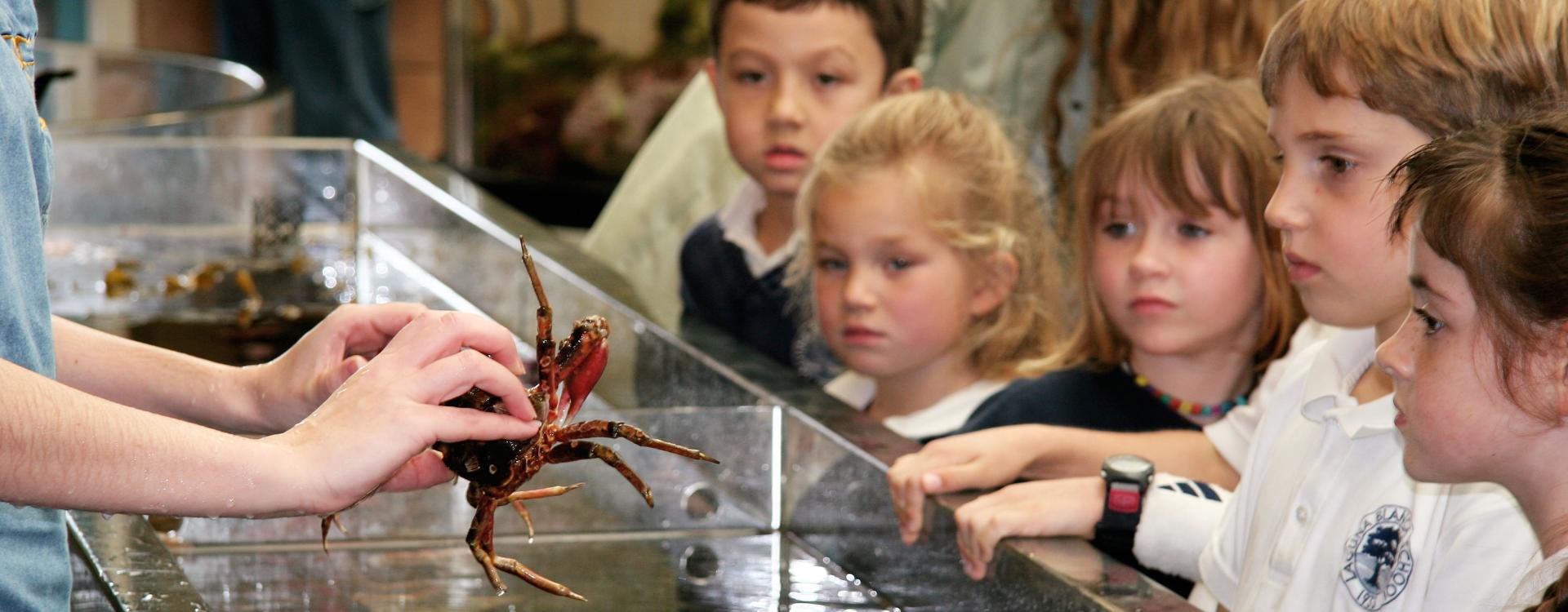
Kindergarten kids look attentively to a crab held by a docent over touch tank at The REEF. Photo Credit: Monica Pessino
“You don’t have to be a scientist to love and protect the ocean,” says marine biologist Scott Simon.
Simon is the director at UCSB’s teaching aquarium, the Research Experience and Education Facility (or REEF for short). Although used as a lab facility by the university, the REEF is primarily devoted to public outreach and serves as a popular destination for school field trips because of its extensive touch tank system, interactive exhibits, and Simon’s unique approach to scientific communication.
Simon’s father had fond memories of Santa Barbara from his childhood and made it a priority to move to Santa Barbara, relocating the family when Simon was just halfway through second grade. Simon would attend Peabody, Roosevelt, Santa Barbara Junior High, and Santa Barbara High School, but in the summer he and his siblings spent their days in the water.
“My parents were frugal and going to the beach was free,” says Simon. “I grew up in the ocean. My grandfather taught us to snorkel and pluck abalone. So from a very young age, this love for the marine environment was instilled in me.”
Simon supplemented his days in the water with part-time jobs, working as a dishwasher, a nail-puller, and a carpenter. He credits the effective communication style he has today to this real-world experience: “It teaches you to think in a different way. Scientists have a reputation for being bad communicators. I work really hard to figure out ways to improve that perception.”
That’s where the “REEFers” come in.
As a teaching aquarium, educators are the heart and soul of the REEF. Each year Simon recruits and mentors new UCSB undergraduates to become REEFers. When picking the new team members, Simon prioritizes two things: A love for the ocean and diverse perspectives. Specifically, Simon makes an effort to hire students outside marine sciences.
“It’s not just all aquatic biology majors, and it is really important that not everyone wants to be a scientist.”
The REEF’s extensive touch tank display lets visitors get up close and personal with local and foreign marine life. Simon explains the touch tanks are such a powerful education tool because they allow visitors to better appreciate the world around them.
“People will protect what they know,” says Simon. “I want to show people the really cool organisms right in our front yard and try to get people to embrace this and hopefully go gain a better understanding themselves.”
From 2,000-gallon tanks hosting sea hares, stars, and slugs to in-house celebrities such as LUV the Moray Eel and Boris the senior lobster, there are animals for all to enjoy. If you visit the REEF, you may even spot Simon next to his favorite display, the red and white abalone colonies. Abalone are close to Simon’s heart because they remind him of his formative ocean experiences but also because of the animals’ extended layover on the endangered species list. But thanks to diligent conservation work, their numbers are on the rise again.
Success stories like the rise in abalone numbers motivate the team at UCSB to continue on their mission of scientific outreach and education. Pre-pandemic, the teaching tools at the REEF reached between 20,000 and 25,000 visitors each year. However, the true impact of the REEF stretches beyond the facility itself when REEFers graduate and start their own careers as veterinarians, teachers, researchers, and science communicators. This impact is made possible by donations and grant writing efforts that allow the team to expand the REEF and pay the REEFers who not only work as ocean advocates but also educate the next generation of ocean advocates.
To learn more or to donate to the REEF visit https://msi.ucsb.edu, or contact Scott Simon at scott.simon@ucsb.edu.